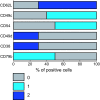Surface-antigen expression profiling of B cell chronic lymphocytic leukemia: from the signature of specific disease subsets to the identification of markers with prognostic relevance
- PMID: 16509989
- PMCID: PMC1457000
- DOI: 10.1186/1479-5876-4-11
Surface-antigen expression profiling of B cell chronic lymphocytic leukemia: from the signature of specific disease subsets to the identification of markers with prognostic relevance
Abstract
Studies of gene expression profiling have been successfully used for the identification of molecules to be employed as potential prognosticators. In analogy with gene expression profiling, we have recently proposed a novel method to identify the immunophenotypic signature of B-cell chronic lymphocytic leukemia subsets with different prognosis, named surface-antigen expression profiling. According to this approach, surface marker expression data can be analysed by data mining tools identical to those employed in gene expression profiling studies, including unsupervised and supervised algorithms, with the aim of identifying the immunophenotypic signature of B-cell chronic lymphocytic leukemia subsets with different prognosis. Here we provide an overview of the overall strategy employed for the development of such an "outcome class-predictor" based on surface-antigen expression signatures. In addition, we will also discuss how to transfer the obtained information into the routine clinical practice by providing a flow-chart indicating how to select the most relevant antigens and build-up a prognostic scoring system by weighing each antigen according to its predictive power. Although referred to B-cell chronic lymphocytic leukemia, the methodology discussed here can be also useful in the study of diseases other than B-cell chronic lymphocytic leukemia, when the purpose is to identify novel prognostic determinants.
Figures




Similar articles
-
Cluster analysis of immunophenotypic data: the example of chronic lymphocytic leukemia.Immunol Lett. 2011 Jan 30;134(2):137-44. doi: 10.1016/j.imlet.2010.09.017. Epub 2010 Oct 13. Immunol Lett. 2011. PMID: 20923685
-
Surface-antigen expression profiling (SEP) in B-cell chronic lymphocytic leukemia (B-CLL): Identification of markers with prognostic relevance.J Immunol Methods. 2005 Oct 20;305(1):20-32. doi: 10.1016/j.jim.2005.07.004. Epub 2005 Aug 8. J Immunol Methods. 2005. PMID: 16198366
-
A scoring system based on the expression of six surface molecules allows the identification of three prognostic risk groups in B-cell chronic lymphocytic leukemia.J Cell Physiol. 2006 May;207(2):354-63. doi: 10.1002/jcp.20570. J Cell Physiol. 2006. PMID: 16331666
-
Morphological and immunophenotypic features of chronic lymphocytic leukemia.Rev Clin Exp Hematol. 2000 Mar;4(1):22-47. doi: 10.1046/j.1468-0734.2000.00002.x. Rev Clin Exp Hematol. 2000. PMID: 11486329 Review.
-
Chronic Lymphocytic Leukemia B-Cell Normal Cellular Counterpart: Clues From a Functional Perspective.Front Immunol. 2018 Apr 4;9:683. doi: 10.3389/fimmu.2018.00683. eCollection 2018. Front Immunol. 2018. PMID: 29670635 Free PMC article. Review.
Cited by
-
Extensive surface protein profiles of extracellular vesicles from cancer cells may provide diagnostic signatures from blood samples.J Extracell Vesicles. 2016 Apr 15;5:25355. doi: 10.3402/jev.v5.25355. eCollection 2016. J Extracell Vesicles. 2016. PMID: 27086589 Free PMC article.
-
MYC protein expression and genetic alterations have prognostic impact in patients with diffuse large B-cell lymphoma treated with immunochemotherapy.Haematologica. 2013 Oct;98(10):1554-62. doi: 10.3324/haematol.2013.086173. Epub 2013 May 28. Haematologica. 2013. PMID: 23716551 Free PMC article.
References
-
- Binet JL, Auquier A, Dighiero G, Chastang C, Piguet H, Goasguen J, Vaugier G, Potron G, Colona P, Oberling F, Thomas M, Tchernia G, Jacquillat C, Boivin P, Lesty C, Duault MT, Monconduit M, Belabbes S, Gremy F. A new prognostic classification of chronic lymphocytic leukemia derived from a multivariate survival analysis. Cancer. 1981;48:198–206. - PubMed
-
- Rai KR, Sawitsky A, Cronkite EP, Chanana AD, Levy RN, Pasternack BS. Clinical staging of chronic lymphocytic leukemia. Blood. 1975;46:219–234. - PubMed
-
- Gattei V, Degan M, Gloghini A, De Iuliis A, Improta S, Rossi FM, Aldinucci D, Perin V, Serraino D, Babare R, Zagonel V, Gruss HJ, Carbone A, Pinto A. CD30 ligand is frequently expressed in human hematopoietic malignancies of myeloid and lymphoid origin. Blood. 1997;89:2048–2059. - PubMed
-
- Krober A, Seiler T, Benner A, Bullinger L, Bruckle E, Lichter P, Dohner H, Stilgenbauer S. VH mutational status, CD38 expression level, genomic aberrations, and survival in chronic lymphocytic leukemia. Blood. 2002;1000:1410–1416. - PubMed
LinkOut - more resources
Full Text Sources

